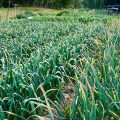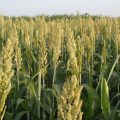Sweet corn, table corn, or sugar corn, is one of the sweetest, most important staple crop next to rice. Scientifically, sweet corn is called Zea mays rugosa, a cultivar of field corn (Zea mays L.). Production of special types of corn such as popcorn, waxy (or glutinous) corn, high lysine/tryptophan corn, and sweet corn was found to be very promising as livelihood for farmers. This is because sweet corn is simpler to grow, labor-saving, less prone to insect pest infestation, and is oftentimes more profitable than growing corn for grain.

Sweet Corn is monoecious, having male flowers on top of the plant and female flowers (silks) at leaf axis along the main stem. The male flower, called the tassel, can produce up to a million pollen grains. The pollen begins to shed several days before the female silks emerge, but continues to produce pollen and mature for many days. Pollen moves by wind and gravity. It is for this reason that single rows of corn don’t usually pollinate and yield as well as many rows side-by-side. The ear, or female flower, is enclosed in several layers of “husk” with only the fine string-like styles or silks emerging above for pollination. The ovaries are produced in rows along the upright axis of the spike or cob. After fertilization they develop into kernels.
As the plants are wind pollinated they should be grown in blocks rather than rows, 45cm (18in) apart. Sweet corn can also cross-pollinate with other types of corn. If sweet corn is planted downwind of popcorn or field corn, kernels will be starchy instead of sweet. Cross-pollination between white and yellow cultivars will change the colors of the kernels. Extra-sweet and standard cultivars also should not be planted near each other or at the same time. To prevent cross-pollination problems, sweet corn should be separated from different types of corn by at least 400 yards, different types or cultivars of corn should be planted at least 1 month apart, or cultivars with different maturity dates should be planted.
Sweet Corn Production Guide
Sweet Corn Varities
There are many varieties of sweet corn:
SE – Sugary Enhancer Hybrids
SH2 – Super Sweet Hybrids
SU – Normal Sugary Hybrids
Heirloom
SE, or sugar enhanced hybrids, have the highest sugar content of any sweet corn varieties. They do not need to be isolated from other sweet corn categories when planted in the garden.
SH2, or super sweet hybrids, are very sweet and have a crisp texture. They must be planted separate from other corn varieties to prevent cross-pollination.
SU, or normal sugar hybrids, have the highest yields. However, they are not quite as sweet or crisp as the SE or SH2 varieties. The flavor and texture is very good. SU varieties are considered the standard of quality among sweet corn varieties. No isolation is needed when planted with other sweet corn varieties.
Heirloom sweet corn is known for its full flavor and substantial texture. Some heirloom varieties can be traced back more than 100 years. Heirloom sweet corn should be planted away from other corn varieties to prevent cross pollination.
Land Preparation
Plowing and Tilling. Prepare the land properly for the ideal growth of the sweet corn seed that you will plant. Good plowing and tilling of the land will help avoid early growth of weeds in your corn farm.
For light soil, it is recommended that you plow the land once and till it also once.
For clay or heavy soil, it is recommended that you plow the land once and you till it twice with 7-10 days interval for the tilling.
Furrowing. On the day of sowing, build furrows with a 70 centimeter distance from each other and a depth of 8 centimeters for wet season or 10 centimeters for dry season.
Growing Conditions
There are just a few simple rules to follow to grow a bumper crop of sweet corn.
Site. Select a site on the north side of your garden. Corn plants are tall so that if planted on the north side, they will not cast shadows on the other garden plants that decrease plant production. The optimum temperature range is 60 to 85 degrees F. Below 50 degrees F. corn will not grow.
Soil. The ideal soil for corn is a loamy sand or sandy loam. As a general guide, plant early corn in light soil (sand or loam) and late corn in heavier soil (silt, clay) when there is an option. Light soils warm up faster than heavy soils, so seed germinates more readily. Under hot, dry midsummer conditions, heavier soils have the advantage of holding much more moisture than light soil.
Water. Sweet corn is a heavy water user. While sweet corn needs ample water from germination to harvest, the most critical period for water is about 2 weeks before silking. A deficit of water during this period will seriously impair quality. Aim for one inch of water per week, supplementing natural rainfall with irrigation.
Planting
Row Spacing: 2 1/2 to 3 feet
Plant Spacing: 8 to 10 inches between plants. An alternative arrangement is to plant hills which are 2 to 3 feet apart with 3 to 4 plants per hill.
Seeding Depth Early plantings: no deeper than one inch; later plantings: 1 to 2 inches – plant more deeply on lighter soils.
Succession Planting. For a continuous supply of corn throughout the season, plant a small amount of the same variety every 7 to 10 days or simultaneously plant varieties with different dates to maturity.
Fertilizer Application (before planting and 30 days after planting)
Basal Fertilizer. Before planting, apply the fertilizer evenly at each furrow and cover it with soil that has a depth of 2-3cm to prevent the seeds from touching the fertilizer. The quantity of fertilizer to be used depends on the result of the soil test conducted on your land or the recommended rate of fertilizer use.
Sidedressing. Add nitrogen-based fertilizer (Urea) on the sides of each plant, scatter the fertilizer linearly with a 4-6cm distance from the base of the corn plant. Cover the fertilizer by hilling the soil up with a depth of 8-10cm.
Fertilization Rate
Amount of fertilizers to be applied (Bags/Ha.)
| BASAL (B) SIDEDRESS (S) | Low (70-35-70) | Medium (120-60-120) | High (150-75-150) |
| Alternative #1 B = 14-14-14 | 5 bags 2 bags 2 bags | 8 bags 2 bags 3 bags | 11 bags 3 bags 3 bags |
| Alternative #2 B = 18-46-0 | 2 bags 2 bags 1 bag 2 bags | 3 bags 4 bags 3 bags 3 bags | 4 bags 5 bags 3 bags 4 bags |
| Alternative #3 B = 16-20-0 | 4 bags 2 bags 2 bags | 6 bags 4 bags 3 bags | 7 bags 5 bags 4 bags |
| Alternative #4 B = 10-10-20 | 7 bags 2 bags | 12 bags 3 bags | 15 bags 4 bags |
| Yield Target | 3-5 MT | 5-7 MT | 7-10 MT |
Irrigation
Irrigate the land on the designated dates of irrigation if needed especially during the dry season. The recommended schedule of irrigation is: 0-3 days, 13-15 days, 30-35 days, 45-55 days and 65-80 days after planting.
Weed Control
Weeds can be controlled by using black plastic mulch or a hay or straw mulch. Lay the black plastic before planting, punch small holes through the plastic and push the corn seed down to the appropriate depth. Plants will grow through the hole. Apply hay mulch after the plants are 4 to 5 inches high.
In addition to mulching, do shallow cultivation, off-barring, and spot weeding 12-20 days after planting and may be repeated 35 days after planting. These practices are effective in controlling weeds. The best time to destroy weeds is when they are small.
Herbicide (OPTIONAL). Use pre-emergence herbicide, such as Pendimethaline or Atrazine, 1-2 days after planting. Follow the right amount of herbicide to be used for a 16-liter sprayer, as indicated in its label.
Insect Pest Management
Corn borer, corn earworm, and flea beetle are the chief insects to be controlled in sweet corn. Follow the spray or dust schedules the restrictions on the label. Proper timing in applying insecticides is important if you want worm-free corn. Carbaryl (Sevin) can be used to control corn earworm. On early and mid-season varieties, four to seven applications will give 85 to 90% worm-free ears. Make the first application when 10% of the silks are out, and repeat every other day until 90% of the silks have wilted. On late varieties, the earworm may be almost impossible to control with any kind of spray program.
Plant Disease Control
Visit you corn field regularly. Immediately remove corn plants that manifest symptoms of diseases, such as leaf blight and stalk rot. Burn the diseased plants.
Harvesting
The temperature at which sweet corn is harvested and stored can have a dramatic effect on eating quality. Sweetness is of prime importance in sweet corn quality; after harvest, sweetness rapidly declines as the sugar in the kernel is converted to starch. The loss of sugar in the kernels is accelerated by high temperature. For example, the rate of sugar loss is 10 times greater when the corn is held at 70oF. than at 32oF. At 90oF., the rate of loss is 20 times greater than at 32EF.
Although supersweet types of sweet corn retain sweetness much longer than the normal types, it is important to harvest any sweet corn in early morning or late evening.
Storing
After harvest, store corn in the refrigerator to retain the most flavor. Sweet corn can be stored by canning or freezing. The easiest method is freezing. Blanch corn for 8 to 10 minutes, then chill thoroughly in cold water and freeze.
Sources:
Year of the Sweet Corn, National Garden Bureau
Sweet Corn Varieties, Backyard Vegetable Gardening
Production performance of sweet corn (Philippine Supersweet 1, Azukar var.) as affected by level of nitrogen and planting density in Capiz, PCARRD-DOST
Organic Sweet Corn Production, North Carolina Cooperative Extension Service
Sweetcorn, Royal Horticultural Society
Hybrid Corn Production, Pioneer
Growing Sweet Corn, UNH Cooperative Extension
Growing Sweet Corn, Purdue University Cooperative Extension Service







Where can I buy sweet corn in Metro Manila area? Or near province bulacan pampanga
where can I buy certified seeds for Japanese sweetcorn? Are there any suggested brands? Thank you.
Where to buy sweet corn seeds for planting.
how many water it intake per day per plant?
easy to produce but hard to market in a large scale
how many days to maturity for sweetie sweet corn?
..misz red knuh?? jaji
in making thesis, which you do not include the study of fertilizer, is it necessary to apply fertilizer when making an experiment, which is not part of the plan??
Where I can buy these kind of variety corn seeds? pls help… Thanks
try natin after the harvest of those old variety of corn we planted sweetie.
To Jocelyn Bernadas Beltran
Shall we try planting sweet corn aside from the present variety of corn we grow?